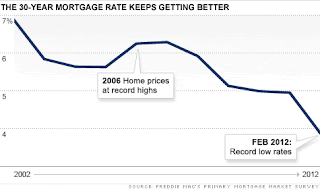The 30-year, fixed rate fell to an average of 3.87% and the 15-year fixed dropped to 3.14% for the week ending February 2, both the lowest rates ever recorded in the 40-year history of the Freddie Mac Primary Mortgage Market Survey.
Frank Nothaft, vice president and chief economist at Freddie Mac said the rates fell to new lows after the fourth quarter gross domestic product report last week showed that the economy was growing at a rate that fell short of expectations.
The new record rates were "fortuitously timed" for the Obama administration to announce its latest refinancing proposal, said Greg McBride, senior financial analyst at Bankrate.com.
The plan, which requires approval by Congress, would allow borrowers who are current on their mortgage to save an average of $3,000 a year by refinancing into loans backed by the Federal Housing Administration.
Has Obama's housing policy failed?
"A lot more homeowners figure to get help over the next few months and that intersects nicely with these attractive rate terms," said McBride.A year ago, mortgage borrowers were thrilled to get 30-year mortgages averaging 4.81%. These days they're finding ones nearly a full point lower.
The difference in the monthly payments between a 4.81% loan and a 3.88% is about $54 for every $100,000 borrowed. For someone with a loan balance of $250,000 that comes to more than $1,620 a year.
But many of the borrowers that Obama's plan would help currently have mortgages that carry interest rates of 6%, 7% or higher. If someone with a $250,000 mortgage carrying a 7% rate could refinance into a 3.88% loan, it would reduce payments by nearly $6,000 a year.
Such bargains figure to be around for awhile. In fact, they could get even better, according to McBride. Mortgage rates closely track bond yields, which plunged after the Federal Reserve said it expects to keep the Federal Funds rate near historic lows until late 2014.
The yield on a 10-year bond has nose-dived since the Fed's action, falling from 2.05% on Jan. 25 to 1.81% on Feb. 1.Foreclosure's hardest hit neighborhoods
McBride said the difference between mortgage rates and bond yields, the spread, widens when yields decline. After yields stabilize again, the spread should shrink.
The usual spread is about 1.7 percentage points, according to Keith Gumbinger of HSH Associated, a provider of mortgage data and information. Currently, it's about 2 points.
If it dropped to the normal average of 1.7 points, the interest rate on a 30-year could plunge to 3.5%.
The views, opinions, positions or strategies expressed by the authors and those providing comments or external internet links are theirs alone, and do not necessarily reflect the views, opinions, positions or strategies of First Capital, we make no representations as to accuracy, completeness, current, suitability, or validity of this information and will not be liable for any errors, omissions, or delays in this information or any losses, injuries, or damages arising from its display or use. Any information provided does not constitute an offer or a solicitation to lend. Providing information to purchase does not guarantee a loan approval. All registered trademarks, copyright, images, or other items used are property of their respective owner and are used for editorial purposes only.
First Capital Mortgage is a subsidiary of PHH Home Loans LLC, a direct lender, Dept. of Corporations file #413-0713
Visit First Capital Online or call: 310-458-0010




No comments:
Post a Comment
Note: Only a member of this blog may post a comment.